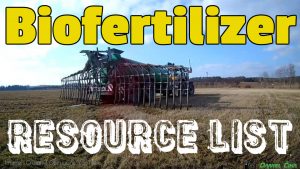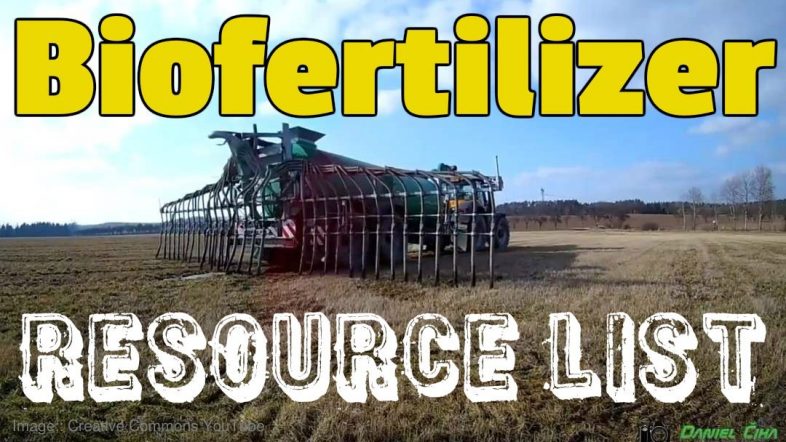Biofertilizer (or in the UK Biofertiliser) will become a major source for plant fertility in agriculture in the future*. That's why we have compiled this resource page, defining biofertilizer and listing topics of importance re: biofertilizer and diBiofertiliser (the name for “digestate biofertilizer”). A major benefit of biofertilizers comes from the presence of “plant-growth promoting rhizobacteria” (PGPR) – (See Resource No. 1 below).
 The main sources of biofertilizer in fairly large quantities (although not normally available from retail outlets and usually spread on neighbouring farms close to the producing facility), are:
The main sources of biofertilizer in fairly large quantities (although not normally available from retail outlets and usually spread on neighbouring farms close to the producing facility), are:
i) compost – aerobically produced decomposed organic matter,
ii) the by-product of anaerobic digestion, which is called digestate.
However, anaerobic digestion process based biofertilizer is not the only type of biofertiliser included in the resource list which follows.
Digestate biofertilizer is an excellent source of nitrogen (N) to apply to grassland, and crops as part of a scientifically based and field by field sampled and tested nutrient plan. UK farmers apply the guidance given in Defra‘s Fertiliser Manual (RB209).
Research done on food-based crop digestate showed 80% of the total N to be readily available in this biofertilizer, compared with only 10 – 25% in farmyard manure. according to http://beefandlamb.ahdb.org.uk
Biofertilizer crop yield can be higher compared with manufactured NPK applications, as a result of the additional potash supplied by the digestate. Experiments on a grassland site in Wales showed that food-based digestate increased yields by 5% when a soil potash deficit was present initially.
The 3 Forms of Digestate Biofertilizer
Digestate comes in three forms:
- Mixed (as it comes out of the digester, and this looks similar to slurry),
- Liquid (solids removed by using a digestate separator), or
- Fibre (looks similar to compost, with or without maturation in windrows).
In most locations the dominant form when used in for agriculture is “mixed” (liquid and fibrous).
Not only does the diBiofertiliser nutrient content vary from digester to digester. Uptake will depend upon the extent to which there is a nitrogen (N) deficit in the soil.
For that reason it is essential to obtain a recent nutrient analysis before deciding to use it.
UK
Avoiding Excessive Nitrogen Loss to the Environment
Due to its high ammonium content, there is great potential for N losses to the environment when spreading digestate, which reduces its nutritional value.
* How can we be confident about biofertilizers becoming a major source of plant fertility in agriculture?
We can be confident in our prediction because manufactured chemical based fertilizer is a finite resource in the same way as fossil fuels are finite.
RESOURCE LIST:
1. Biofertilizer – Wikipedia
A biofertilizer (also bio-fertilizer [biofertiliser UK) is a substance which contains living microorganisms which, when applied to seeds, plant surfaces, or soil, colonize the rhizosphere or the interior of the plant and promotes growth by increasing the supply or availability of primary nutrients to the host plant.
Biofertilizers add nutrients through the natural processes of nitrogen fixation, solubilizing phosphorus, and stimulating plant growth through the synthesis of growth-promoting substances.
Biofertilizers can be expected to reduce the use of synthetic fertilizers, and perhaps surprisingly also reduce the need for pesticides. The microorganisms in biofertilizers restore the soil's natural nutrient cycle and build soil organic matter.
Through the use of biofertilizers, healthy plants can be grown, while enhancing the sustainability and the health of the soil. Since they play several roles, a preferred scientific term for such beneficial bacteria is “plant-growth promoting rhizobacteria” (PGPR).
Therefore, they are extremely advantageous in enriching soil fertility and fulfilling plant nutrient requirements by supplying the organic nutrients through microorganism and their byproducts. Hence, biofertilizers do not contain any chemicals which are harmful to the living soil.
Biofertilizers provide “eco-friendly” organic agro-input. via Wikipedia
2. UK WRAP on Biofertilisers
Making the most of quality diBiofertiliser: A biofertiliser is any bacterial or fungal inoculant applied to plants with the aim to increase the availability of nutrients and their utilization by plants, regardless of the nutrient content of the inoculant itself. via Plant biostimulants
3. Digestate and Compost on UK farms
WRAP provides the following re-assurance:
Renewable fertilisers can increase yields and reduce costs with no impact on crop quality.
DC-Agri data will enable farmers to predict how much nitrogen digestate will supply to crops. (WRAP website)”
Article titles available: “Making the most of quality digestate and compost on your farm”. “BSI PAS 110.” “Producing quality digestate (biofertiliser) DC-Agri project. Digestate and compost in agriculture, research and knowledge exchange project”. via WRAP UK
The UK Farmer's weekly provides tips on using anaerobic digestate as a fertiliser here.
4.Plants Grow Best on Soil that is Full of Life
For healthy plants, the soil needs to be teeming with life, like trillions of beneficial microbes combined with vermicast and biochar. As with any ecosystem, there is a need for biodiversity below the ground level as much as above it. Hence, organic bio fertilisers like Arktivate can help rebuilt that natural and beneficial balance in the soil.
5. Organic and Natural Fertilizer Products
BioFertilizer is a natural and organic fertilizer with nutrients and live microorganisms that required by the plants. Life is more than N-P-K, the soil is alive and contains a lot of microorganism and good bacters that produce natural nutrients for agriculture and plants. Using chemical products eventually will kill all this micro live and transform productive soils in sand and salt in few years. via O and N Fertilizers Products
6. ReGrow Sustainable Natural and Effective Fertilizer
At our ReFood Anaerobic Digestion plants we do more than just produce energy. We also make a high-quality biofertiliser that’s completely sustainable. We call it ReGrow.
It’s good for soil fertility and health. Which in turn is good for crops. Which in turn is good for consumers and supermarkets.
It’s a closed loop process that keeps on giving. via ReGrow
7. Digestate Biofertiliser – UK Certification Scheme
The Biofertiliser Certification Scheme (BCS) provides assurance to consumers, farmers, food producers and retailers that digestate produced from anaerobic digestion is safe for human, animal and plant health. Biofertiliser is the name adopted for the quality digestate that meets the PAS110 & ADQP or ASRS specification.
BCS is part of Renewable Energy Assurance Ltd, a subsidiary of the Renewable Energy Association. Plants are assessed by two independent Certifying Bodies and an independent Panel oversees the BCS.
Digestate that achieves certification is no longer classed as a waste and can be spread beneficially to land without the need for an Environmental Permit, providing a valuable source of organic, carbon-free fertiliser. via Biofertiliser – Certification Scheme
8. Examples of Commercial Biofertiliser Products
a) The nitrogen-fixing capability of Azolla has led to Azolla being widely used as a biofertiliser, especially in parts of southeast Asia. Indeed, the plant has been used to bolster agricultural productivity in China for over a thousand years. When rice paddies are flooded in the spring, they can be inoculated with Azolla, which then quickly multiplies to cover the water, suppressing weeds. The rotting plant material releases nitrogen to the rice plants, providing up to nine tonnes of protein per hectare per year. via Azolla – Wikipedia
b) Our slow-release, granular GSC Organic Tomato Fertilizer (5-6-5) gives your tomatoes all the nutrients they need, including plenty of phosphorus for big, abundant fruit. For a healthy start, mix a handful into the soil at transplant time and then side dress when tomatoes begin to set fruit. via Organic NPK Ratio …
c) Our bio fertilizers also help improving quality, taste and yield of crops. With stronger immune systems of the crops, it enhances capabilities of defense on negative conditions such as problems of climate change, diseases and pests. Our products also improve problems of soil compaction and help reducing the dependence of crops on convention chemical fertilizers. via LKB
d) List of biofertilizer companies, manufacturers and suppliers in USA via Suppliers in USA
9. How to Make Your Own Bio Fertilizer
Bio fertilizers can be used instead of harmful chemical fertilizers and improve soil fertility, which ultimately leads to better quality crops or plants. The most common type of bio fertilizer is compost, and it is composed from things you typically discard in the trash, including fruit and vegetable peels, some types of paper and dry leaves. By following the steps outlined in this article, you can create your own bio fertilizer in your backyard. via DoItYourself.com
Biofertiliser is a ferment made from a biological base in water and enriched with foods to feed biology and minerals for biology to digest. The final product becomes a solution that contains chelated minerals, biocoloides, hormones, biocatalysts, and micro-organisms. via RegenAG
RHIZOBIUM: A Natural Biofertilizer Shefali Poonia Department of Botany, D.N. College, Meerut, U.P, INDIA. Nitrogen is an essential nutrient for plant growth and development. Legumes play an important role in sustainable management of dry arid regions. via RHIZOBIUM
10. A Biofertilizer Disadvantage of Real Concern – Microplastics found in biofertilizers are being applied to gardens and farmland
Many organic fertilisers being applied to gardens and farms contain tiny fragments of plastic, according to a new study.
Widely considered a problem affecting the oceans, this work suggests microplastics may actually be far more pervasive.
Having entered the soil, the scientists behind the study have warned these tiny fragments could end up in the food we eat.
The production of organic fertilizers is generally considered environmentally friendly as it involves recycling food waste from households and other sources to make useful products that can be used to grow more food.
However, contamination of the waste used to produce these fertilizers – which are used by gardeners and farmers alike – means tiny microplastics are making their way into the soil. via Microplastics
11. Pathogen Risks from Biofertilizer?
There is little published research into the pathogen risk of using products derived from animal by-products, however, a minimum of three weeks between spreading and grazing or harvesting is recommended to negate any risks. In addition, in the UK this type of digestate will have been pasteurised to comply with the Animal-byproducts Regulations (ABPR).
Digestate must be noted down in Nitrate Vulnerable Zone (NVZ) records and, where derived from livestock manures or slurries, must be accounted for in the farm average livestock N loading (170 kg/ha/year). via AHDB.



You omitted I think to mention one very important UK political change last year when Defra, Parliament & WRAP all began at last singing from the same hymmsheet? The well-known Waste Hierarchy now correctly shows AD above Composting, which some of us have been lobbying for a long time rightly so. Studies have shown that AD is actually slightly more financially & economically better also, a fact often misunderstood by local authorities who now should be digesting organic waste rather than composting it! Ideally, local authority & private plants should combine both on the same location.
Thanks for pointing out the change to the Waste Hierarchy which I had not been aware of.
I also agree wholeheartedly with your statement: “local authorities who now should be digesting organic waste rather than composting it”. Strangely, our local food waste collection goes into our garden-waste wheelie, which is composted. That’s done, I presume, simply to save the council money?
Are you advocating that garden waste should go to anaerobic digestion as well as food waste? In principle I would agree for everything non-woody, and yet wouldn’t that be more expensive (in gate fee charges) than composting, and therefore an impossible thing to ask for in view of further impending LA funding cuts?
Thanks for prompt response. The probable reason your foodwaste goes with garden waste to composting (same as our local council!) is down to (a) longterm waste collection contracts, (b) council customary practice based on believing it’s the cheapest (not so!) and unfamiliarity with AD and change process involved (with cutback shortages), (c) Waste hierarchy previously placed composting above AD? Our community group have just met with our council (9 months after receiving our ‘free’ detailed study proposal for beneficial switching of all their foodwaste & market agricultural waste from composting to AD to save them cost & CO2. The change in policy was also raised & they are in the process of appraising new longterm collection contract with major UK consultant. (Kind of David & Goliath situation for us!)
Some garden & municipal waste will be OK for AD, (and even Indians have used AD for lignin feedstock, but maybe dry rather than wet process?). That’s why I was suggesting ideally councils should have combined plant to optimise process for all feedstock collected. In our area in 2011, a county council residual bin composition survey found 26% was foodwaste which goes to either EfW or RDF (destroying the potential fertiliser!) & pays an extra £62/Te gate fee over composting!! Furthermore, average foodwaste caddy setout rate for our council (only one of 10 statutorily requiring source segregation!) is only 35% (worse in urban locations)! Commercial foodwaste is much worse with probably most going as residual to EfW or RDF (& some maybe to landfill?). Virtually all UK councils are the same I suggest, and continuing failure of government to legislate policy requirement for all commercial foodwaste source segregation, and pre-process in waste stations by producers that recover all resource for subsequent collection and AD (i.e. polluter pays!) is appalling economic loss (& environmental pollution!). Our study has also identified significant opportunities for further savings in the process of collection & processing. But, who is listening?
Good post. I am being taught something challenging on totally different webs everyday. Looks like it’s time to consider getting into this. Thanks for sharing.
I came across your “Biofertilizer Resource List – It’s a Must-Have!” with web page. I found it useful but can I ask you a question. You say excessive nitrogen loss to the environment. I heard that ammonia emissions were a problem for biogas digestion.